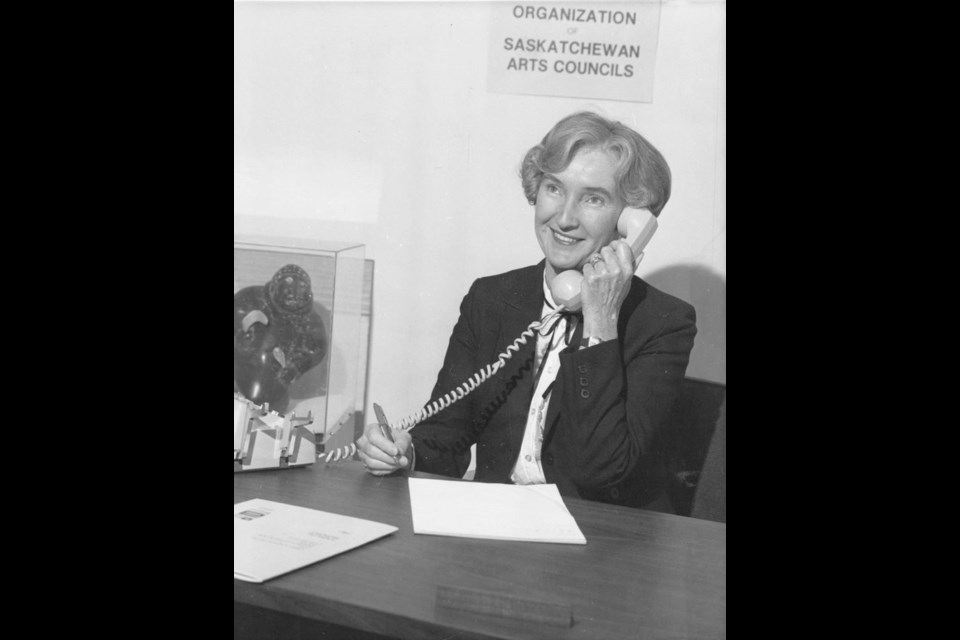Lynn Gidluck hopes she can do justice to the role that Estevan played in the growth of the Organization of Saskatchewan Arts Council (OSAC), and bringing culture to communities.
Gidluck is the author of a yet-untitled book that is slated to be released this year. She works with Benchmark Public Relations, and the book will be released through Benchmark Press.
“We are getting close to completion,” Gidluck said in an interview with Lifestyles. “I have a first draft done, which I’m getting ready to send off to the good folks in Estevan to take a look at. Whenever you’re trying to reconstruct history, you can only do so much with the historical documents that you have.”
She is glad that many of the people who played a key role in the rise of OSAC are still alive.
The book focuses on the years from 1974 to 1987, when OSAC’s head office was in Estevan. The story actually starts in 1948, when the Saskatchewan Arts Board was established. It was the first organization of its kind in North America.
“I don’t think I’ve ever met a more passionate supporter of the arts and the community than Marguerite.” Lynn Gidluck.
The first individual arts council was in Weyburn.
“There was a lot of people on those original boards that wanted to see the arts promoted in rural Saskatchewan,” said Gidluck.
Individual arts councils continued to pop up across the province, and they were largely independent. In 1968, OSAC was established, bringing some unity to the different councils.
In 1974, OSAC recruited Gallaway to be the executive director, thanks to the work she was doing locally to support concerts and the arts. Incredibly enough, the head office was in Estevan for those years.
“I don’t think I’ve ever met a more passionate supporter of the arts and the community than Marguerite,” said Gidluck.
Gallaway was also a fierce negotiator, Gidluck said, which allowed her to bring artists of international acclaim to Estevan for tours.
In those first few years, Gidluck said OSAC wasn’t able to pay Gallaway much of a wage, even though Gallaway was crisscrossing the province in an effort to establish arts councils in smaller communities. During her tenure, OSAC grew from a small number of arts councils to 62.
“There are still arts councils in communities big and small across the province,” said Gidluck. “I’m from the community of Biggar … and there’s an arts council up there that is all part of the work Marguerite did.”
Growing up in Biggar, she almost took for granted the concerts that were booked through OSAC and brought to smaller communities.
Gidluck met Gallaway while working on a book about the history of Sask Sport and its deep connection with Saskatchewan Lotteries. They spoke about how the lotteries support cultural agencies. It was the first time she learned about Estevan’s connections with OSAC.
But the person who initiated Gidluck’s book on Estevan’s role with OSAC was the late Evelyn Johnson, a long-time Estevan resident and a champion of arts and culture who died last year. Johnson spent more than 40 years on the local arts council, including 15 years as the chair.
She was named a life member of OSAC in 1997.
“Evelyn was really convinced that not very many people recognize how fortunate Saskatchewan is to have such a well-established and vibrant system of arts council,” said Gidluck. “No provinces in Canada have anything like what Saskatchewan has with our arts councils, where smaller communities get to see provincial, national and even international-calibre performances.”
Gidluck agrees with Johnson’s sentiment that not many people realize the contributions of Gallaway and others from Estevan to OSAC. And she is sad Johnson died before the book was completed.
She spoke to a number of other people for the book, including former Estevan Mercury editor Norm Park, to get their recollections about OSAC during its time in the Energy City.
Gidluck says she has always had a keen interest in history. She loves hearing stories that speak to Saskatchewan’s uniqueness, and the growth of OSAC in the 1970s and 1980s is one of those unique stories that makes her proud to be from Saskatchewan.
“When you hear the stories of people working together to build something that’s so marvellous, it makes me really happy to be a storyteller, and to share that with other people,” said Gidluck. “We do have a lot to be proud of, and Estevan certainly can take pride in the fact that this work really started in Estevan, and now communities across the province are still able to have concerts and art shows in their communities that, in a lot of other provinces, it’s restricted to the larger cities.”
Everyone should have access to arts and culture, she said, and not just those in larger centres, she said.
Once the book has been reviewed, Gidluck said the photos and the design will have to be selected. And, of course, a name also has to be finalized. It should be available early in the fall.
She’s not sure if there will be a local book launch once it is released, but she noted the Estevan Arts Council provided some funding for the project, so they might want to have some sort of an event.
Gidluck said it has been a privilege to work with this project, and she is excited to promote good news stories like this one from smaller Saskatchewan communities.



